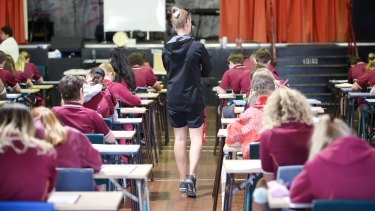By PASI SAHLBERG in the Sydney Morning Herald.
American journalist and social critic H L Mencken wrote that “for every complex human problem, there is a solution that is neat, simple and wrong”. "Back to basics" or phonics tests are such answers that have been offered to improve Australian schools.
Alarm bells were ringing around Australia when the latest PISA results became public on Tuesday. Australia scored its lowest ever results in the global reading, mathematics and science test co-ordinated by the Organisation for Economic Co-operation and Development. Should we be worried?
CREDIT: ADAM MCLEAN
In need of a revamp ... this year's NAPLAN test.
When alarm bells ring, people often panic. But panic is not the right way to react to PISA results here in Australia. Instead, we need to step back and take a good look at the bigger picture that the OECD’s study also offers.
Here are some lessons to consider. It is not just Australia in steady decline. New Zealand, Canada (except in Alberta), Japan, Korea, the Netherlands and Finland are heading in the same direction. Actually, the 37 OECD countries, the wealthiest in the world, on average, are doing worse in PISA than previously.
Hence, the main question to be asked is not: What are our schools and teachers doing wrong? Instead, we should be asking: What is possibly causing this downward trend in many countries now?
Many teachers in Australia, Finland and elsewhere claim students have changed dramatically during the past decade. According to research done by the UNSW’s Gonski Institute for Education, three of five teachers in Australia believe there has been a clear decrease in students’ readiness to learn at school. Over 80 per cent of teachers think digital devices are a growing distraction to students. Almost all teachers reported that the number of children arriving at school tired has increased.
Put simply, young people are not what they used to be.
Teachers in Canada and Finland, both slipping down in international school comparisons, experience this change in their schools the same way. Today, teenagers spend eight hours or more with their digital devices every day. This time is away from something that is directly linked to how well, or poorly, they learn in school. Or, do in PISA and NAPLAN.
A recent study by the Australian Institute of Family Studies found that a quarter of students aged 12 to 15 in Australia suffer from lack of good sleep. Most children have too little daily physical activity, have unhealthy eating habits, and have more mental health concerns than previously. No wonder, then, that they don’t learn as well.
Everybody’s asking what is going on in Finland? Once a poster child of education, now it is going downhill with many others. Interestingly, young Finns today spend their time very much the same ways as their Australian peers. That is why Finnish youngsters also suffer from having too little of the important daily ingredients of growing up ready to learn: Time to read, play outdoors and sleep well.
Rather than suggesting haphazard, simple solutions to improve student learning, we should consider PISA as evidence for the following next steps.
Make equity in education the highest priority. PISA 2018 shows again that the most successful education systems are those that invest equally in equity and excellence. In Australia, this means, among some other things, funding schools based on their real educational needs.
Give teaching, not testing, the highest priority. There are no successful education systems that use standardised testing as we do with NAPLAN, which pits schools against each other in a pointless contest. Australia needs a much smarter NAPLAN that gives teachers and schools a central role in deciding how children learn.
We should focus systematically on student and teacher wellbeing. Research shows that a significant number of students today are distracted and not ready to learn the complex skills and knowledge required in schools today. Parents and schools together must find new ways to help young people to live and learn healthier and better.
